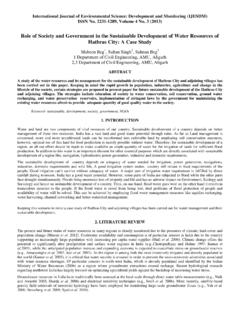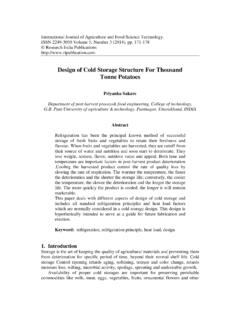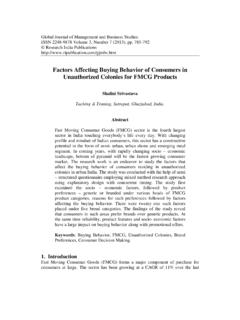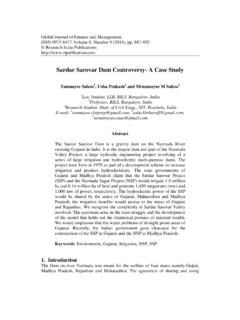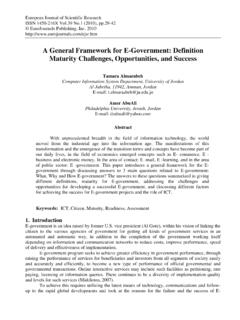Transcription of Challenges before Mechanical Engineers
1 International Review of Applied Engineering Research. ISSN 2248-9967 Volume 4, Number 3 (2014), pp. 257-268 Research India Publications Challenges before Mechanical Engineers Rajnish Prakash E-mail: Abstract This article deals with advancements in engineering and its impact on human life. After listing the most important twenty advancements in the twentieth century, the grand Challenges before Engineers are presented. Role of Mechanical engineering in meeting the Challenges in the context of India are highlighted.
2 It is concluded that future Mechanical Engineers will deal with large systems and projects and on the other side info-nano-bio systems. The kind of education to such Engineers be provided, the curricula, contents and pedagogy are discussed. The existing curricula as well pedagogy need transformation. Keywords: Challenges to Engineers , Role of Engineers , Mechanical engineering education. 1. Introduction Throughout human history, engineering has driven the advance of civilization.
3 The metallurgists ended the Stone Age by producing copper and iron. The shipbuilders united the world s peoples through travel and trade. Increasingly sophisticated tools for agriculture, technologies for producing textiles, inventions transforming human interaction and communication, Mechanical clock and the printing press irrevocably changed civilization. In the recent past Industrial revolution impacted life and thought in a big way. Machines supplemented and replaced human labor for countless tasks.
4 The steam engine facilitated mining, powered trains and ships, and provided energy for factories. Improved systems for sanitation enhanced health in the western world. The technology is intimately related to economics. There is a theory in business that the economy moves in long cycles, called Kondratieff waves, driven by technological innovation. According to the theory, each of these breakthroughs spurs a long boom of rising prosperity, then a turning point and a crisis. The first such wave Rajnish Prakash 258came with the invention of the steam engine and the revolution in the textiles industry.
5 The second was the building of the railways, the third in chemicals and electrical engineering. Since then economists have suggested two more, the rise of the car, and then the invention of the internet and digital technologies. There is a wave of innovation going on around alternative energy, and in the fields of biotech and nanotechnology too. It may result in sixth wave. Whether it results in an economic wave or not, it is certain that technology definitely influences the life as we live.
6 In essence the basic purpose of engineering is to devise, design and provide devices, machines, buildings, structures, systems and processes to promote, improve, sustain, protect or defend the material living standards of humans. 2. Achievements of Past Century There have been spectacular advancements in various areas of technology. National Academy of Engineering {NAE}, under a project published a book A Century of Innovations: Twenty Engineering Achievements That Transformed Our Lives in 2003.
7 It documents the innovative inventions in 20 areas viz. Electrification, Electronics, Telephone, Radio and Television, Computers, Internet, Imaging, Laser and Fiber Optics, Automobile, Airplane, Spacecraft, Refrigeration, Air Conditioning and Highways, Water Supply and Distribution, Agricultural Mechanization, Health Technologies, Household Appliances, Technologies, Petroleum and Petrochemical Nuclear Technology High Performance Materials. Contents of the book are now available on The Greatest Engineering Achievements website.
8 The website contains detailed historical information, timelines, and personal essays by key innovators for each of 20 major engineering accomplishments of the 20th century. The impact of these developments is seen by all of us, and many experience them in daily life. The impact has been felt in all walks of life- social, economic, political, climatic environments. It has had a great effect on personal, family, and community life style a great deal. The rigour in life is eased today.
9 Although these technological developments have made the life comfortable and more enjoyable, there are some unintended outcomes which need to be addressed. 3. What is Engineering? Engineering is the application of scientific, economic, social, and practical knowledge in order to design, build, and maintain structures, machines, devices, systems, Challenges before Mechanical Engineers 259 materials and processes. It may encompass using insights to conceive, model, scale an appropriate solution to a problem and achieve an objective.
10 The discipline of engineering is extremely broad, and encompasses a range of more specialized fields of engineering, each with a more specific emphasis on particular areas of technology and types of application. Modern engineering needs close association and affinity with science and mathematics. Engineering is based principally on natural sciences and their extensions into material science, solid and fluid mechanics, thermodynamics, transfer and rate processes, and systems analysis. The function of the scientist is to know, while that of the engineer is to do.

